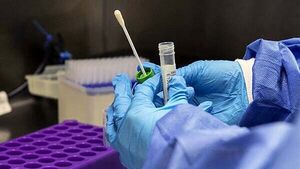Almost 1,500 people hospitalised with Covid-19 in October, latest data shows

Sarah Slater
Almost 1,500 people have been hospitalised with Covid-19 in October, the latest data shows.
Nursing homes and hospitals nationwide continued to be hit the hardest by new Covid-19 cases, the Health Protection Surveillance Centre (HPSC) figures show from week 40 to 43, the first three weeks of October.
However, the numbers contracting the virus have plummeted compared to the summer months, with figures spiking at almost the 600 mark.
The data shows there were 221 new cases last week, 98 people needed to be hospitalised, there were no admissions to Intensive Care Units (ICU), and there were no deaths. But there were 10 deaths in week 40, three in week 41 and three in week 42.
The Integrated Respiratory Virus Bulletin from Thursday highlights that Covid-19 activity was at low to moderate levels. The overall incidence was 4.3 per 100,000 population.
Cases decreased by 37.2 per cent, from 352 cases notified in week 42 to 221 cases in week 43. Hospitalisations decreased by 18.3 per cent, from 120 cases in week 42 to 98 cases in week 43, while hospital bed occupancy has been decreasing in recent weeks.
XFG remained the predominant variant. XFG accounted for 83.1 per cent of cases between weeks 36 and 40 this year, while NB.1.8.1 accounted for 13.8 per cent of cases during the same time period.
There were 15 classified “outbreaks” last week, and there have been 91 of them from October 1st to 21st.
Of the outbreaks in healthcare settings, nursing homes have been the worst affected with almost 300 cases reported in late April, but it has now plummeted to around 50 last week, with hospitals being hit by 25 to 50 consistently, residential homes and community and long stay settings.
From January 1st last to the start of June, the average number of cases stood between less than 100 to 200, however, from June until the end week of August, cases have steadily climbed to almost 600 cases per week. This month, they have dropped right back to an average of around 300 to less than 150.
Those aged 65 or older still represent the largest proportion of cases last week and for the entire year to date, with numbers rising to almost 300, followed by the 45 to 64 age group and the 15 and 24 range.
There has been a consistently low number of ICU admissions from January to August, while deaths have also been in single-digit numbers weekly.
The counties worst affected by Covid in October are Dublin, followed by Cork, Louth, Kildare, Kerry, Limerick, Galway, and Tipperary. The least number of reported cases for the month has been in Laois.
In a statement, the Health Service Executive said in relation to deaths from Covid-19 so far this year that “County-level data on deaths is not provided due to small numbers and medical confidentiality.
“Covid-19 deaths are defined as a death in a person with laboratory-confirmed Covid-19 infection, this includes cases detected postmortem. These data are provisional due to the time delay with death registration in Ireland.”
Official Covid-19 figures are acknowledged to underreport the true prevalence of the virus, due to a reduction in testing since the pandemic.
In relation to influenza or the flu, activity increased but was below baseline levels up to Sunday of last week. The overall incidence was 2.8 per 100,000 of the population. There were 144 influenza cases notified in week 43, which was October 20th to 26th, compared to 119 the week previous. There were 24 influenza hospitalisations, no ICU admissions and no deaths notified last week.
Although influenza hospital bed occupancy remained low, it has been increasing slightly in recent weeks.
RSV activity was at low levels and has stabilised last week. The overall incidence was 0.7 per 100,000 population. There were 36 cases notified compared to 40 in week 42. There were 16 RSV hospitalisations and no ICU admissions or deaths reported. RSV hospital bed occupancy remained low and stable in recent weeks.
There were 20 acute respiratory infection (ARI) outbreaks notified during week 43, including 15 Covid-19, two influenza and three other upper chest infection cases, the same number as reported during week 42.
Of the 20 outbreaks, one was in a community/long-stay unit, seven were in hospitals, nine in nursing homes and three in residential institutions. There were no RSV outbreaks notified during week 43.
According to the HSE, the most recent flu vaccine uptake for this winter season, so far up to the start of October, shows that numbers are slightly behind numbers for the same period last year in the older age group.
Up to 28 per cent of those aged 60 plus have received the flu vaccine so far, compared to 29 per cent for the same period last year. In the age group two to 17, almost five per cent have gotten the vaccine compared to three per cent last year.
The HSE outlined that the National Immunisation Information System collects vaccination data. “The vaccine uptake target is 50pc for children aged two to 17 and 75pc for those aged 60 and over.
“(Others include) healthcare workers, pregnant women, carers and household contacts of people with a health condition, residents of nursing and older person homes, long stay facilities, (those with disabilities) and those who have close or regular contact with pig, poultry and waterfowl.”






